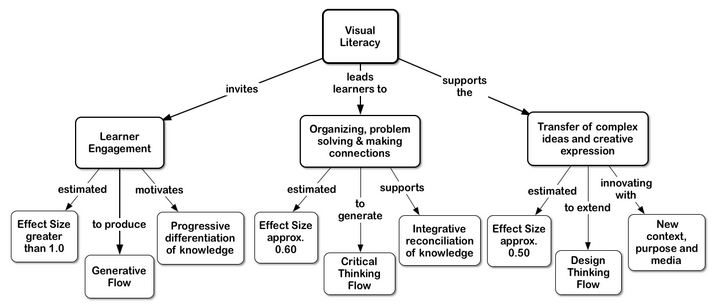What should teachers know about visual literacy?
The scope of visual literacy in education now extends beyond illustrative content, symbols, diagrams and charts to encompass drawing and painting, moving images, animations and multimodal media.
Although the main thrust of education is still text based, there has been a dramatic shift in the the way we interact with information that is not primarily text based. We have become a much more visually affected and engaged society. YouTube provides many with an alternative to the text based canon, indeed it is the search engine of choice for many young people. Real time information, both personal, and as news, is shared instantly in real time using visual devices and platforms. Educational communications have developed from text based forms such as email to live video conferences and use social media platforms. Educational events are broadcast and annotated live, presentations uploaded for all to access.
Today visual information is inextricably linked to digital tools and platforms, whether that be for consumption, creation, publishing and sharing; or any combination of those. It is unlikely they can ever be completely separated.
Visual literacy strategies like concept mapping and creating videos have a large impact on student dispositions (attitudes, interest,) and achievement (Hattie, 2009). Visual literacy is especially important in the elementary or primary school years as learners make the transition from viewing and speaking to formal language acquisition and incorporate the rules of speaking and writing, and from making marks and drawing to letters, language and text-based learning. Concept maps and graphic organizers are effective tools for meaningful learning (Novak and Canas, 2006), critical thinking (Beaudry, 2014); engaged, high-quality reasoning processes (e.g., comparison, analysis, design) and products that mark the progression of knowledge for teachers and learners.
Concept maps are flexible tools for allowing students to reveal the active construction of new understanding by generating and answering their own questions, to make novice errors, to support students’ collaborative dialogue, and to focus teacher-expert feedback on students’ individual formative assessment products. Misconceptions can be revealed to the teacher in an efficient and precise manner, with a quick look. During this process students learn how to make focused revision, and teachers gain another source of data for students to triangulate with other sources like interviews, students’ writing, other performance skills, and tests and quizzes. (Beaudry and Wilson, 2009). The potential impact of visual literacy is quite large, with a major impact on students’ engagement and dispositions, and short- and long-term memory. See Figure 2.

Figure 2: Phases of Visual Thinking and Concept Mapping (Beaudry, 2014)
The following references are part of the evidence base for this resource.
Beaudry, J. (2014). Visual Literacy for Teaching and Learning: Essential Knowledge and Skills to Create, Use and Assess Concept Maps and Graphic Organizers.
Leask, M., and Burden, K., & Younie, S. (Eds.) Learning to Teaching Using ICT in the Primary School. London, UK: Routledge.
Beaudry, J. (2014). Thinking critically about visual representations: A visual journey to understand critical thinking. Cases on Teaching Critical Thinking through Visual Representation Strategies. L. Shedletsky and J. Beaudry. (Eds.). Hershey, PA: IGI Publications.
Beaudry, J., and Wilson, P. (2009). Concept mapping and formative assessment: Elements supporting literacy and learning. Handbook of Research on Collaborative Learning and Concept Mapping. Torres, P. and Marriott, R. (Eds.). Hershey, PA: IGI Publications.
Canas, A. and Novak, J. http://cmap.ihmc.us/docs/theory-of-concept-maps
Davies. J., Merchant. G.,. Web 2.0 for schools. (2009), Peter Lang,
Buckingham. D., Beyond Technology, (2007), Polity
Hattie, J. (2009). Visible Learning. Routledge: New York, NY.
Scorcese., M., The Importance of Visual Literacy (video) http://youtu.be/I90ZluYvHic
Created by students for teachers, this video shows students frustrated with the lack of visuals in the classroom. Teachers need to educate themselves on the hidden language of visuals. https://www.youtube.com/watch?v=6MBo2Ak4gXU
Belshaw. D., (2013) The Essential Elements of Digital Literacy v.07,
Andersen, M., Wagner, J, and Warner, B., (2002) Visual Literacy The Internet & Education,

